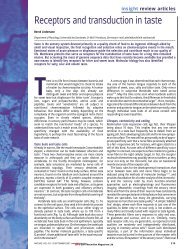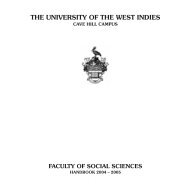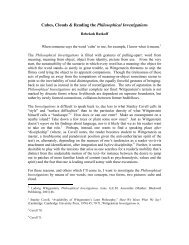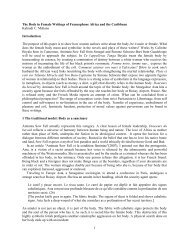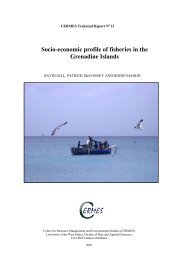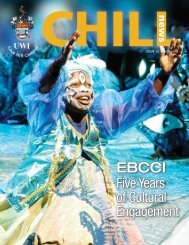THE SUSTAINABLE GRENADINES PROJECT - The University of ...
THE SUSTAINABLE GRENADINES PROJECT - The University of ...
THE SUSTAINABLE GRENADINES PROJECT - The University of ...
Create successful ePaper yourself
Turn your PDF publications into a flip-book with our unique Google optimized e-Paper software.
Petitjean examines the different islands in the Eastern Caribbean who are given aid by the Japanese to their respective<br />
fishing industries including St. Vincent and the Grenadines and Grenada. Table VI shows Japanese aid to the various<br />
fisheries sectors in St. Vincent and the Grenadines. <strong>The</strong> report focuses on, the effects <strong>of</strong> the aid from the point <strong>of</strong> view <strong>of</strong><br />
the fishing industry, government and politicians <strong>of</strong> the islands and also from the donor country. It gives reference to other<br />
reports such as the Caribbean development Bank Annual Report 2001 which indicate economic growth <strong>of</strong> each island<br />
<strong>The</strong> Appendix further examines fisheries complexes in St. Vincent and the Grenadines and Grenada. Table XIV shows<br />
some type <strong>of</strong> aid provided for the four complexes in St. Vincent and the Grenadines, three <strong>of</strong> which are on the Grenadines<br />
islands <strong>of</strong> Bequia, Canouan and Union.<br />
Phillip, P.E. and Rennie, J. 1993. <strong>The</strong> flying fish fishery <strong>of</strong> Grenada p. 159. In: H.A. Oxenford, R. Mahon and W.<br />
Hunte (eds.) <strong>The</strong> Eastern Caribbean Flyingfish Project. OECS Fishery Report No. 9.<br />
Flyingfish, primarily Hirundicthys affinis, landings have declines sharply over the last 12 years from around 866.7 mt per<br />
year in 1978 to 11.5 mt in 1990. the importance <strong>of</strong> flyingfish as a component <strong>of</strong> the total food fish landings in Grenada has<br />
also declines from representing 42% <strong>of</strong> the total landings in 1978 to just 0.64% in 1990. Whilst flying fish has declined in<br />
importance as a food fish, it has increased its importance as a “baitfish”, being the primary bait used in the developing<br />
longline fishery. <strong>The</strong>re is a strong possibility that the flying fish fishery will now develop entirely as a bait fishery. With<br />
flying fish being landed and stored for use as bait year round in the longline fishery, which is presently constrained by the<br />
lack <strong>of</strong> bait in the flyingfish “<strong>of</strong>f season”. <strong>The</strong> traditional fishing technique (hook and line and dipnet) have now been<br />
replaced by the surface gillnet. <strong>The</strong>re is no fishery management for the flyingfish in Grenada.<br />
Pickerill, R.K., S.K. Donavan, and R.W. Portell. 2002. Bioerosional Trace Fossils from the Miocene <strong>of</strong> Carriacou,<br />
Lesser Antilles Caribbean Journal <strong>of</strong> Science. Vol. 38, No. 1-2, 106-117 pp.<br />
This paper documents a relatively diverse assemblage <strong>of</strong> macroborings from the Miocene <strong>of</strong> Carriacou in the Grenadines,<br />
Lesser Antilles. <strong>The</strong> borings occurs in molluscan and scleractinian coral substances associated mainly with the Middle<br />
Miocene Grand Bay Formation. <strong>The</strong> document provides evidence that suggest that the Grand Bay Formation is a deepwater<br />
turbiditic sequence.<br />
Potter, R.B. 1992. St. Vincent and the Grenadines. World Bibliographic Series. Vol 143. CLIO Press Ltd. Oxford,<br />
England. 212 pp.<br />
A bibliography <strong>of</strong> various documents written on St. Vincent and the Grenadines.<br />
Powell, R. and R.W. Henderson. 2005. A New Species <strong>of</strong> Gonatodes (Squamata: Gekkonidae) from the West Indies.<br />
Caribbean Journal <strong>of</strong> Science, Vol. 41, No. 4, pp 709-715.*<br />
In this article Powell and Henderson provided a description <strong>of</strong> a new species <strong>of</strong> Gonatodes from remnant dry forest on<br />
Union Island, St. Vincent and the Grenadines. <strong>The</strong> new species was distinguished from all congeners by its small size, large<br />
body scales (39-44 around midbody; >70 in all congenerics), a bright red-orange iris, and a unique pattern <strong>of</strong> three pairs <strong>of</strong><br />
prominent dorsolateral ocelli on the body. <strong>The</strong>y discussed the biogeographical implications <strong>of</strong> the new species’ Lesser<br />
Antillean distribution and its conservation status.<br />
Price, N. 1988. Behind the Planters Back: Lower class responses to marginality in Bequia island, Macmillan, St.<br />
Vincent, Macmillan Caribbean (Basingstoke). 274 pp.<br />
Detailed ethnography <strong>of</strong> a small, lower class Afro-Caribbean community on the island <strong>of</strong> Bequia in the St Vincent<br />
Grenadines.<br />
Price W.S. 1985. Whaling in the Caribbean: Historical perspective and update. Rept. Int. Whal. Comm. 35: 413-<br />
420.<br />
Not seen.<br />
45






